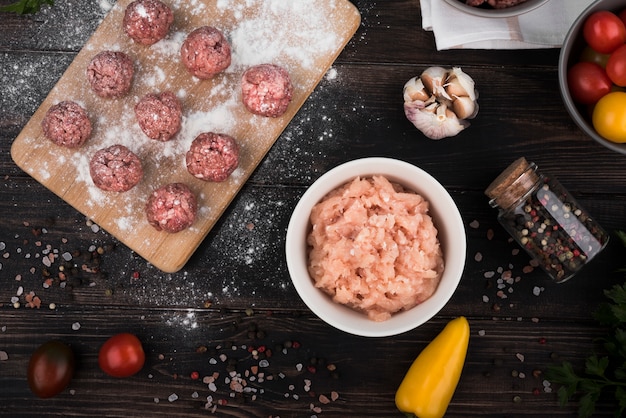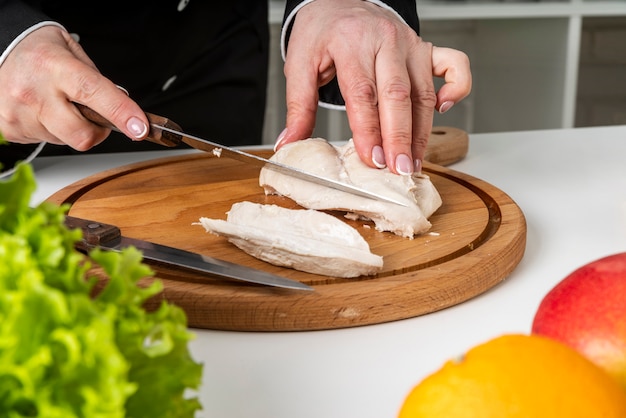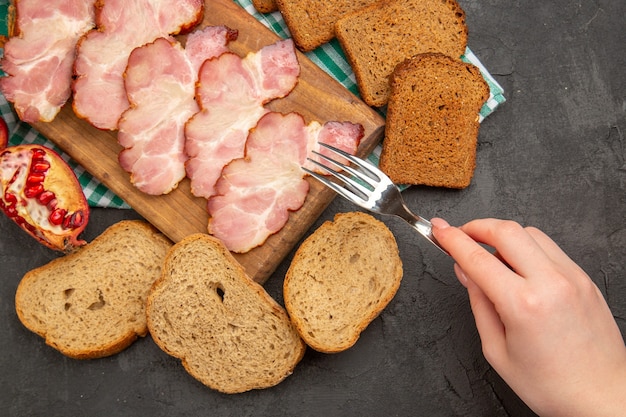Let's be honest, a raw ham isn't your average weeknight dinner. It's more of a grand occasion dish, a showstopper that demands attention and, let's be frank, a decent amount of time. But let me tell you, the reward is worth the effort. There's nothing quite like the salty, smoky, succulent flavour of a perfectly cooked ham, the glistening fat, the aroma that fills your home... It's a culinary experience, a real feast for the senses. And guess what? It's not as daunting as you might think. I've cooked my fair share of hams over the years, and I've learned a few tricks along the way that will help you create a masterpiece.
Part 1: Choosing the Right Ham

First things first, you need to pick the right ham. I'm talking about a raw, bone-in ham, not the pre-cooked stuff you find at the supermarket. Trust me, there's a whole other level of flavour and satisfaction to be had with a properly cooked raw ham. And believe me, once you've tasted the difference, you'll never go back!
The Importance of Choosing a Raw Ham
The main reason why I always recommend a raw ham is the flavour. It simply can't be compared to a pre-cooked ham. The curing process, whether dry or wet, develops a depth of flavour that's just not achievable with pre-cooked hams. Think of it like the difference between a fresh, homemade loaf of bread and a store-bought one.
Choosing the Cut
So you've decided on a raw ham, great! Now, you need to choose the right cut. You've got two main options: a whole ham, or a half ham. A whole ham is obviously bigger, perfect for a large gathering or if you want plenty of leftovers. A half ham is more manageable, great for a smaller crowd or if you're just cooking for your family.
And here's a little tip: Don't be afraid to ask your butcher for advice. They know their stuff and can help you choose the right size and cut for your needs. They'll be able to recommend a ham that's perfect for the number of people you're feeding and the size of your oven. They might even have some great ideas for flavour combinations and cooking techniques!
The Type of Ham
Now, the type of ham. This is where things get a little more nuanced. You've got your dry-cured hams and your wet-cured hams. Each has its own unique characteristics, so it's worth knowing the differences before you make your choice.
Dry-cured hams, as the name suggests, are cured in a dry environment, often with salt and sometimes with spices. This process takes time, usually months, and results in a deeply flavoured ham with a firm texture. The curing process draws out moisture, which concentrates the flavour and gives the ham a salty, almost sweet taste.
Wet-cured hams, on the other hand, are cured in a brine, often with sugar and other flavourings. This process is quicker, taking a few weeks, and results in a juicier ham with a more delicate flavour. The brine keeps the ham moist, making it more tender.
Personally, I'm a big fan of dry-cured hams. The flavour is incredible, and I love the way the fat renders down during cooking, adding a rich, almost buttery flavour to the meat. But if you're looking for something more tender, a wet-cured ham might be a better choice. It really comes down to personal preference. If you're unsure, ask your butcher for their recommendation.
Part 2: Prepping the Ham

Once you've got your ham, it's time to prep it for cooking. This might seem intimidating, but it's really quite straightforward. It's all about getting the ham ready for its star turn.
Soaking the Ham
If you're working with a dry-cured ham, you'll need to soak it before cooking. This helps rehydrate the ham and makes it more tender. Think of it like giving the ham a nice, long bath! I usually soak mine in cold water for 24 hours, changing the water every 8 hours. It's a bit of a chore, but it's worth it in the end. The ham will be so much juicier and more flavorful.
Now, you might be wondering if soaking is necessary for wet-cured hams. The answer is: it depends. Some wet-cured hams are already quite moist, so soaking isn't always necessary. But if you want to be extra sure, you can soak it for a few hours to make sure it's rehydrated.
Removing the Rind
Next, you need to remove the rind. This is the tough outer layer of the ham. It's mostly there for protection during the curing process, but it's not edible. You can do this with a sharp knife, or you can ask your butcher to do it for you. I usually ask my butcher to do it, because he has a special tool for it, and it makes the job so much easier.
Once the rind is off, you'll see a layer of fat underneath. Don't worry, this fat is essential for a delicious and juicy ham. It's also responsible for that lovely golden-brown colour and the melt-in-your-mouth texture.
Scoring the Fat
Now, the fun part: scoring the fat. This is where you get to be a little creative. It's not just about aesthetics, it's also about helping the fat render down evenly during cooking, and it allows the flavour to penetrate the ham more deeply.
I use a sharp knife to make diagonal cuts, about half an inch deep, across the fat. Just don't cut into the meat! You want to create a diamond pattern, which will allow the fat to render and the flavour to penetrate. You can also use a fork to make a criss-cross pattern, or even a decorative pattern with a paring knife. Get creative!
Seasoning the Ham
Finally, you need to season the ham. This is your chance to add your personal touch and create a flavour profile that's unique to you. I like to keep it simple, using just salt, pepper, and a little garlic powder. It allows the natural flavour of the ham to shine through. But you can add other spices like paprika, thyme, or rosemary if you like. I've even seen recipes that call for brown sugar or maple syrup. It really comes down to your own tastes.
If you're going for a more intense flavour, try a dry rub. You can find a lot of great dry rub recipes online, or you can create your own. Just make sure to rub it all over the ham, getting into all the nooks and crannies.
Part 3: Cooking the Ham

Now we're getting to the heart of the matter. Cooking a raw ham isn't just about throwing it in the oven and forgetting about it. There's a bit of an art to it, but don't worry, it's totally achievable.
oven roasting
For oven roasting, you'll need a large roasting pan. I like to use a pan with a rack, which helps the fat drain away and keeps the ham from sitting in its own juices. Preheat the oven to 325 degrees Fahrenheit (160 degrees Celsius). Place the ham in the roasting pan and bake for about 20 minutes per pound.
This is just a starting point, as cooking time can vary depending on the size and type of ham. So, it's important to use a meat thermometer to check the internal temperature.
Checking for Doneness
How do you know when the ham is done? The internal temperature should reach 145 degrees Fahrenheit (63 degrees Celsius) for at least 15 minutes. You can check the temperature with a meat thermometer. Insert the thermometer into the thickest part of the ham, making sure not to touch the bone.
If you're not sure, it's always better to err on the side of caution and cook it a little longer. You can always slice a small piece off and check the texture. It should be tender and juicy, not dry or tough.
Glazing the Ham
While the ham is roasting, you can make a glaze to add even more flavour. It's a great way to add a touch of sweetness and a beautiful, glossy finish. I often use a simple glaze made with honey, mustard, and a touch of orange juice. Just brush the glaze on the ham during the last 30 minutes of cooking.
You can also use a glaze made with brown sugar, maple syrup, or even fruit preserves. Just make sure to use a glaze that is heat-resistant, or it will burn.
If you want to get really fancy, you can make a glaze that incorporates herbs and spices, like a rosemary-garlic glaze or a ginger-soy glaze.
Part 4: Resting and Serving
Okay, your ham is cooked! Resist the urge to dive right in. Let it rest for at least 15 minutes before carving. This allows the juices to redistribute, resulting in a more tender, flavorful ham. It's like giving the ham a chance to relax and settle in after its long cooking journey.
Carving the Ham
When it comes to carving, I like to start by slicing off the thick fat layer. This makes carving the ham easier and prevents it from being too greasy. Then, I carve the ham into thin slices, cutting against the grain. You can also use a ham slicer if you have one. It makes for beautiful, even slices.
If you're carving a bone-in ham, you'll need to be careful to avoid cutting into the bone. You can use a carving knife with a sharp, pointed tip to help you navigate around the bone.
Serving the Ham
Now it's time to enjoy the fruits of your labour! I love to serve ham with a side of mashed potatoes, green beans, and a tangy cranberry sauce. It's a classic combination for a reason. But you can also get creative and serve it with other sides, like roasted vegetables, sweet potato casserole, or even a fruit salad.
And don't forget about the ham bone! You can use it to make a delicious ham and pea soup or a flavorful stock for other dishes.
Part 5: Leftovers
leftover ham? Don't even think about throwing it away! It's a delicious ingredient for all sorts of dishes.
Ham and Pea Soup
A classic, hearty soup that's perfect for a cold day. You can use the ham bone to make a flavorful broth, and the ham itself can be added to the soup for extra flavour.
Ham Salad Sandwiches
A quick and easy lunch option. Combine chopped ham with mayonnaise, mustard, and your favourite toppings for a tasty and satisfying sandwich.
ham and cheese quiche
This is a versatile dish that can be made with any type of cheese. It's also a great way to use up leftover vegetables.
Ham and Potato Hash
A hearty breakfast dish that's perfect for a weekend brunch.
Ham and Spinach Pizza
A simple and delicious pizza that's perfect for a weeknight dinner.
Ham and Pineapple fried rice
This recipe combines the sweet and salty flavors of ham and pineapple, making it a tasty and satisfying dish.
Ham and bean soup
A hearty and flavorful soup that is perfect for a cold day.
Ham and broccoli stir-fry
This is a quick and easy dinner option that is both healthy and delicious.
Part 6: Tips and Tricks
Here are a few tips and tricks that I've learned over the years:
- If you're short on time, you can soak the ham for a shorter period. Just make sure to add some extra water to the roasting pan to help keep the ham moist.
- If you're worried about the ham drying out, you can cover it with foil during the first part of the cooking time. This will help to trap in the moisture and prevent the ham from drying out.
- Don't be afraid to experiment with different seasonings and glazes. There are endless possibilities! You can create a unique flavour profile for your ham by using different herbs and spices.
- If you're using a dry-cured ham, be sure to save the soaking liquid. It's a delicious broth that can be used for soups, stews, or risottos.
- If you're cooking a large ham, it's best to do it a day or two in advance. This gives the ham time to cool down and allows the flavours to develop.
- If you're cooking a ham for a large crowd, you can use a roasting pan with a rack to help the fat drain away. This will help to prevent the ham from becoming too greasy.
- Don't overcook the ham. Overcooked ham will be dry and tough. Use a meat thermometer to ensure that the ham is cooked to the proper temperature.
Part 7: Common Mistakes
We've all been there, haven't we? We've all made mistakes in the kitchen. But don't let those mistakes discourage you. We can learn from them and become better cooks. Here are some of the most common mistakes people make when cooking raw ham:
- Not soaking the ham long enough. This can lead to a dry, tough ham. Make sure to soak the ham for the recommended amount of time, especially if it's a dry-cured ham.
- Overcooking the ham. This can also lead to a dry, tough ham. Use a meat thermometer to ensure that the ham is cooked to the proper temperature.
- Not scoring the fat. This can prevent the fat from rendering down evenly, resulting in a less flavorful and less tender ham.
- Not using a meat thermometer. This can lead to an undercooked or overcooked ham. It's the best way to ensure that the ham is cooked to the proper temperature.
- Not resting the ham before carving. This can result in a less juicy and flavorful ham. Allow the ham to rest for at least 15 minutes before carving, so that the juices can redistribute.
Part 8: FAQs
Here are some frequently asked questions about cooking raw ham:
1. What is the difference between a raw ham and a cooked ham?
A raw ham has not been cooked and needs to be cooked before eating. A cooked ham has already been cooked and can be eaten directly from the package.
2. How long does it take to cook a raw ham?
The cooking time for a raw ham depends on its size and type. Generally, a raw ham will take about 20 minutes per pound to cook.
3. How do I know when a raw ham is done?
A raw ham is done when its internal temperature reaches 145 degrees Fahrenheit (63 degrees Celsius) for at least 15 minutes. You should use a meat thermometer to check the internal temperature.
4. Can I freeze raw ham?
Yes, you can freeze raw ham. To freeze raw ham, wrap it tightly in plastic wrap and then place it in a freezer-safe bag. It can be frozen for up to 3 months. To thaw a frozen raw ham, thaw it in the refrigerator for 2 to 3 days.
5. Can I use a crockpot to cook a raw ham?
Yes, you can use a crockpot to cook a raw ham. However, it is important to note that a crockpot can take longer to cook a ham than an oven. You'll also want to make sure that the ham is completely submerged in liquid, such as broth or apple cider.
6. What can I do with leftover ham?
Leftover ham is a versatile ingredient that can be used in a variety of dishes. You can use it in soups, salads, sandwiches, casseroles, and even stir-fries.
Conclusion
And there you have it, folks! A comprehensive guide to cooking a raw ham. It's not as complicated as it seems, really. Just take your time, choose a good quality ham, and follow the steps. You'll be rewarded with a delicious, juicy, flavorful ham that's sure to impress your guests. Now, go forth and conquer that ham!
Everyone is watching

How to Cook Frozen Lobster Tails Perfectly: A Step-by-Step Guide
RecipesLobster. Just the word conjures up images of lavish meals, special occasions, and a taste of luxury. But let's...

Pigs in a Blanket Cooking Time: How Long to Bake for Perfect Results
RecipesAh, pigs in a blanket. Just the name conjures up images of those delightful little parcels of crispy pastry en...

Pork Fillet Cooking Time: How Long to Cook It Perfectly
RecipesPork fillet, or tenderloin as it's sometimes called, is a real favourite in our house. It's so versatile, and...

The Ultimate Guide to Cooking Delicious Frankfurters
RecipesLet's face it, we all love a good frankfurter. It's a classic, simple, and always satisfying. But let's be rea...

The Ultimate Guide to Tender, Juicy Pulled Pork
RecipesRight, let's talk pulled pork. It's one of those dishes that just screams "comfort food," doesn't it? I mean...
